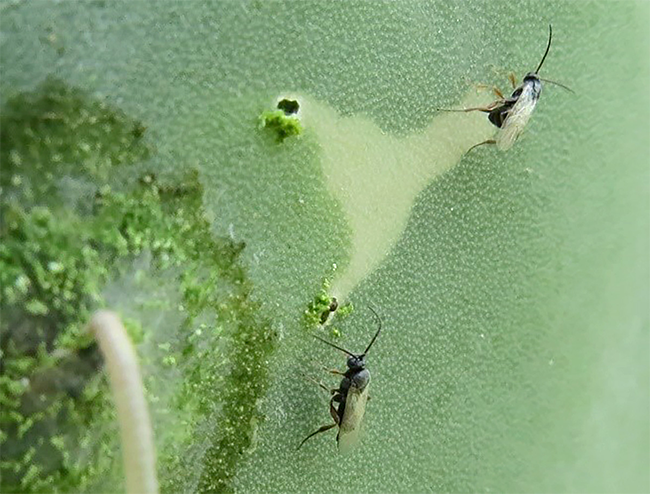Cactus Moth Parasitoid Exported to the United States
Prickly pear cacti (Opuntia spp.) are easily recognizable by the presence of broad flat pads, or stems, typically covered with many spines. They are native to the Americas, and in the United States, they grow in arid and semi-arid regions, and areas prone to drought including the western and south-central states.
The cactus moth (Cactoblastis cactorum) is native to South America and feeds exclusively on prickly pear. The moth caterpillars bore into the pads causing severe damage (Figures 1 and 2), and even death of severely damaged plants.


The cactus moth first arrived in the United States. via the Florida Keys in 1989, and its U.S range is expanding, threatening wild and farmed prickly pears in the United States and Mexico. It is causing significant ecological damage by feeding on wild prickly pears, thereby threatening native desert habitats. Given their protected feeding environment within the cacti pads and widespread and expanding distribution, insecticides are practically useless against this insect, so management research has focused on finding host-specific parasitoids and pheromones.
Parasitoids search for their prey and lay eggs in them to allow their young to develop. Pheromones are species-specific chemical signals emitted by insects to communicate over long distances, which can be used to attract insects to traps or simply confuse mating or other important behavioral characteristics.
The specialized parasitoid, Apanteles opuntiarum, from northern Argentina and Paraguay (Figure 2), was deemed to be quite specific to cactus moth. This parasitoid was studied in collaboration with the ARS Center for Medical, Agricultural and Veterinary Entomology at the Center for Biological Control in Tallahassee, and the Florida Department of Agriculture and Consumer Services (FDACS) lab in Gainesville, Florida. The parasitoid was recently sent to the FDACS quarantine facilities in Florida to complete host-specificity trials on North American caterpillars, to assess if it is safe for release against the destructive cactus moth.
Contact: Guillermo Cabrera Walsh
The Foundation for the Study of Invasive Species (FuEDEI), formerly known as the South American Biological Control Laboratory (SABCL), is located in Hurlingham, Argentina, near Buenos Aires. The SABCL/FuEDEI plays a crucial role collecting and providing candidate biological control agents for South American weeds and pest insects for federal and state cooperators, several U.S. universities, and research collaborators worldwide since 1962. FuEDEI’ s main mission includes exploring for natural enemies of target insects and weeds in Argentina and neighboring countries and conducting host-specificity testing to determine their safety for eventual release in the U.S. In addition, complementary research that investigates the ecology, behavior, taxonomy, and genetic differences based on geographic distribution is conducted on both targets and potential agents. Performing these studies in the region of origin of the target pest serves as an efficient prescreening process that reduces the number of biocontrol agent candidates shipped. This reduces the amount of quarantine work and valuable quarantine space occupation, the expenses related to permitting processes, the risks of escapes, and the release of maladapted or wrongly identified agents to a minimum, saving in costs and hazards. On some occasions these complementary studies help us understand why an exotic organism becomes invasive, which can, in turn, lead to determining novel strategies for their management.
